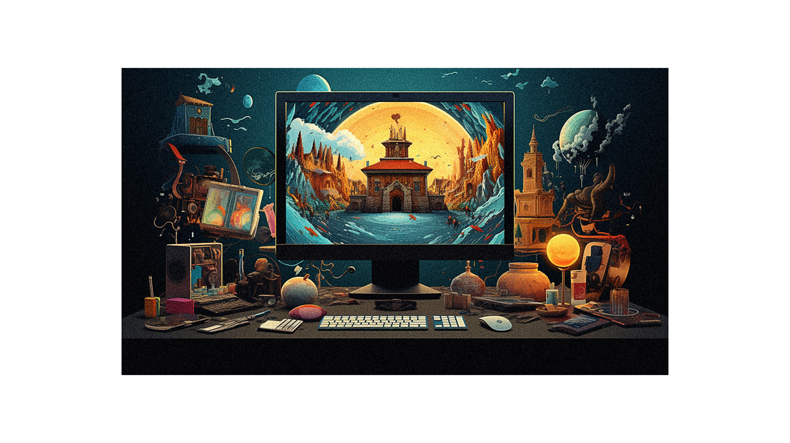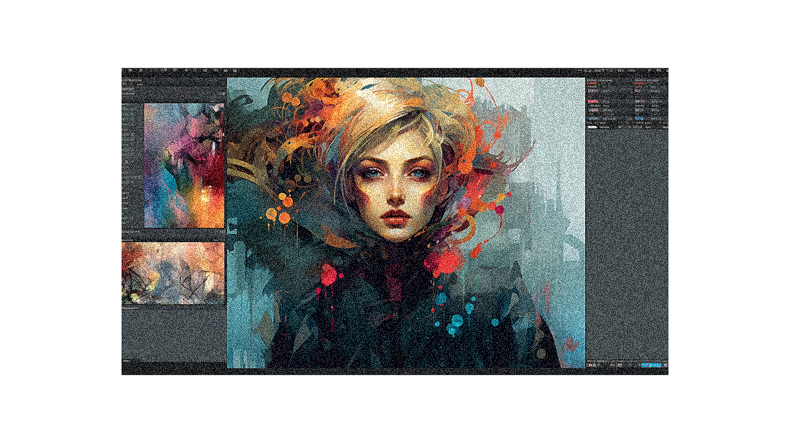Think digital art is too complicated for you? Let me assure you, it’s not! Anyone can create stunning digital artwork with the right tools and practice.
In this article, I’ll guide you through the basics of digital art – from essential hardware and software to understanding layers and brushes. Whether you’re completely new to drawing or transitioning from traditional mediums, there’s something for everyone here.
We’ll also delve into choosing the right canvas size and discuss how various tools function within your chosen software. Plus, we’ll explore some benefits of going digital, like easy edits and endless creativity. However, be aware of certain hardware limitations that might affect your work.
Learning new skills takes time and patience, but mastering digital art will be a breeze with regular practice and experimentation! Ready to jump in? Let’s get started!
What is it?

So, you’re interested in dipping your toes into the vibrant world of digital art, huh? With its roots deeply embedded in artistic media manipulated through technology, digital art is a fascinating realm that has opened up possibilities for artists like never before. It enables them to create and share their imaginative pieces with the world from the comfort of their phones or laptops. It’s a medium that allows you to experiment without fear of wasting materials and offers incredible freedom to create artworks not possible with traditional mediums.
It’s got everything from pixel art and photo manipulations to 3D digital sculpting! But remember, mastering this craft requires understanding both software and hardware. So gear up; let’s embark on this creative journey together!
Tools and Equipment

While you might think getting started with creating digital masterpieces won’t break the bank, it’s not as pricey as expected.
Sure, there are high-end options, but affordable and even free tools exist that can help you on your journey to becoming a digital artist.
The most crucial equipment you’ll need is a drawing tablet and software. You might be surprised that tablets come in various types and prices, from basic pen tablets to display ones.
As for software, while premium options like Adobe Photoshop exist, cheaper choices like Clip Studio Paint or even free ones like Krita exist. The key is understanding what suits your needs and budget best.
Understanding Hardware and Software

Before diving headfirst into your creative journey, it’s crucial to grasp the specific hardware and software that’ll help bring your ideas to life.
You’ll first need a computer or tablet capable of running digital art software. Review the system requirements of any software you’re considering before investing in equipment.
While unnecessary, a graphics tablet can give you better control over your artwork than a mouse.
As for the software itself, there are several options, from professional-grade programs like Adobe Photoshop to more beginner-friendly ones like Krita or Medibang Paint. It’s all about finding what works best for you and your artistic goals.
Choosing the Right Canvas Size

Picking the ideal canvas size is a pivotal step that can significantly influence your final artwork, and you should pay attention to it.
With digital art, you’ve got the freedom to create on canvases of virtually any size. But remember, bigger isn’t always better. Larger canvases demand more from your device’s resources and may slow down your software.
A smaller canvas will suffice if you’re creating art for online use only or more minor prints. However, a bigger canvas is necessary to print your work in larger formats. The resolution also matters – 300dpi to 350dpi for print and about 72dpi for online viewing.
Understanding these factors ensures your artwork retains quality regardless of its intended usage or output medium.
Basic Tools and Functions

Now, let’s dive into the toolbox that’ll be your best friend in this creative journey, full of handy instruments that can turn your wildest imaginations into reality. It might seem overwhelming initially, but trust me, these tools will become second nature once you get the hang of it.
- Brushes: These are your magic wands! They come in various textures and sizes for sketching, coloring,
or adding details.
- Eraser/Rollback: Your safety net when things are unplanned. This tool allows you to fix mistakes without scrapping everything.
- Color Picker: Think of it as your rainbow. This tool allows you to select any color from your canvas or even import colors from outside sources.
Remember – practice makes perfect!
Working with Layers

Having covered digital art’s essential tools and functions, let’s dive into a critical component that can significantly enhance your work – layers.
Working with layers is similar to painting on separate transparent sheets stacked on one another. Each layer allows you to add or adjust elements without affecting the others, which provides flexibility and control over your artwork.
For instance, you can sketch on one layer, color on another, and add effects. If any mistakes are made or changes are needed, you only need to edit that specific layer.
Understanding how to use layers effectively will streamline your workflow and open up new possibilities for creativity in your digital art journey.
Drawing a Digital Art Example

Ready to put your newfound skills to the test? Let’s dive in and create a stunning piece of work using all the tools and techniques you’ve learned.
We’ll be creating a digital koi fish using Clip Studio Paint. We’ll start with a soft purple background, incorporating bubble-like shapes for that water illusion we’re after.
Next, we’ll sketch out our koi fish silhouette in a dark color before adding vibrant orange and yellow tones for the spots.
The moment when you add those first strokes of color – it’s pure magic!
Watch your creation come alive as we layer on more details like scales and eyes.
It’s time to bring that vision to life!
Benefits of Digital Art

You’ll find it fascinating that, according to recent studies, over 60% of artists have adopted digital technology in their workflows. Isn’t it amazing?
The surge in popularity is due to the numerous benefits digital art offers. For instance, it allows for easy editing without damaging the original work – a feature especially handy for beginners like us prone to making errors.
Plus, there’s no fear of wasting materials as we experiment with different techniques and styles. Digital art also provides an incredible freedom to create artworks that would be impossible with traditional mediums.
Above all, sharing our creations online becomes a breeze! Embrace these advantages and let your creativity soar!
Hardware Limitations

Let’s dive into the nitty-gritty of hardware limitations, which are crucial in deciding what type of digital painting you can create. Smaller canvases are your best bet if you’re working with limited hardware. They’ll be perfect for online viewing or small prints.
But if you want to create large-scale digital paintings, you’ll need a more powerful computer or laptop. The amount of RAM and VRAM your device has is significant — it determines how well your system can render strokes and mark-making effects.
So, before diving head-first into digital art, take stock of your hardware capabilities. It’ll save you from frustration later on and ensure a smoother journey through the world of digital creation.
Learning and Practicing Techniques

Mastering the stroke of your stylus and harnessing the power of color and blend modes are essential skills you’ll need to conquer in your journey through this creative realm.
Practice control with your stylus; it’s like learning to write again, but you’ll get there with time. Don’t be afraid to experiment with colors, blend modes, and brush variants. You won’t ruin anything because any changes can be undone or adjusted on another layer without affecting the rest of your artwork.

You’ll want to nail down how to use layers effectively early on. They’re like your safety net, allowing for easy adjustments and changes without damaging other elements in your work.
So go on, dive in, and start experimenting!
Follow us on Pinterest for more tips, tutorials, and artist reviews!
This post contains affiliate links. If you make a purchase, Proactive Creative may receive a small commission at no additional cost to you.





